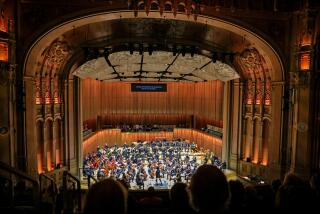MUSIC REVIEW
- Share via
Esa-Pekka Salonen’s Piano Concerto received a brightly confident performance at the Hollywood Bowl on Tuesday night. The date marks the first day in the rest of the life of a major work.
The concerto’s first performance was early in 2007 by the New York Philharmonic. Salonen conducted, and Yefim Bronfman, for whom the concerto was written and to whom it is dedicated, was soloist. Salonen and Bronfman recorded the concerto in Los Angeles last year at Walt Disney Concert Hall, and the CD was released in the U.S. in April to coincide with Salonen’s final concerts as Los Angeles Philharmonic music director.
But for all the excitement a stellar composer/conductor and stellar pianist bring, the concerto needs a ready supply of fresh blood in order to survive in the repertory. The first transfusion was the Los Angeles Philharmonic’s Bowl concert, when a Finnish pianist, Juho Pohjonen, 28, became the first pianist after Bronfman to tackle the concerto. He was accompanied by Lionel Bringuier, 22, the orchestra’s associate conductor. The combined age of both men is a year less than Salonen’s, who turned 51 in June.
There were many striking things about this performance. Salonen and Bronfman are cool customers. Yet the New York premiere was so tense and the new score such a technical challenge that they and the orchestra sweated bullets as they paved the way for future performances.
The concerto already has become, at least in Los Angeles, something that can now be taken in stride. At the Bowl, the small, slim Pohjonen, who is a fraction of Bronfman’s size and still looks like a gawky teenager, knocked off this incredibly difficult solo part with calm, almost cavalier confidence. His fingers flew, and occasionally his long hair flapped. But otherwise he remained unflappable, displaying little expression other than determination. He was deadly accurate.
The Bowl’s video cameras give no performer a place to hide. If Bringuier and the L.A. Philharmonic players appeared excitable, they were in the certain exciting way they are when they play familiar Beethoven or Stravinsky.
Pohjonen, who appeared once before in Los Angeles as a soloist with a visiting Finnish youth orchestra in Prokofiev’s Fifth Piano Concerto, doesn’t have Bronfman’s burly sound or strong personality, so he brings no such baggage. Both he and Bringuier, moreover, are Salonen proteges. They honored the notes they found on the page. What I heard Tuesday was all Salonen all the time.
The concerto begins as with a stately gallop as it rides into many strange territories. Salonen writes in his program note that for the second movement he imagined a post-biological culture of cybernetic systems inventing their own folklore. Mechanical music and freely expressive music are in continual play. The piano part is written in fits of fistfuls of notes.
Amplification this time added a glare to the huge palette of Salonen’s orchestra color. Certain details were lost; I didn’t hear the harp. But others got a helping hand, say by boosting the melancholy saxophone solo near the end of the first movement. Loudspeaker punch also benefited a pianist and conductor who don’t quite have the brawn of Bronfman and Salonen but who contributed their own personal sparks and sparkle.
The audience was not, by Bowl standards, large -- adamant picnickers may feel a modern concerto is an inappropriate digestif. Still, enthusiasm from 5,815 -- more than double Walt Disney Concert Hall’s seating capacity -- is indication enough that a concerto lives.
Bringuier began the program with Dukas’ “Sorcerer’s Apprentice” and ended, as Salonen did in New York after the concerto’s premiere, with Ravel’s orchestration of Mussorgsky’s “Pictures at an Exhibition.” The young French conductor is growing rapidly. In both descriptive scores, he was very French in the musical sense of being understated and tasteful.
Even with the amplification, you could easily sense that textures were crisp and that instrumental colors were vivid. Each Mussorgsky picture had its own satisfying flavor. The “Sorcerer’s Apprentice” didn’t need any assist from Mickey Mouse to fire the imagination. Bringuier will, one day, have a major orchestra of his own. Any opportunity to hear him, while we are lucky enough to keep him in the L.A. Philharmonic’s midst, should not be missed.
--
More to Read
The biggest entertainment stories
Get our big stories about Hollywood, film, television, music, arts, culture and more right in your inbox as soon as they publish.
You may occasionally receive promotional content from the Los Angeles Times.











